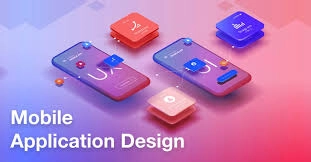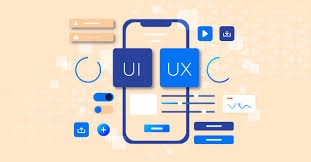In this article, we’ll explore the various facets of Mobile App Design, including key aspects like Mobile App UI Design, App Interface Design, and Mobile App User Experience. We’ll also dive into topics such as Custom Mobile App Design, Mobile App Design Services, and the latest Mobile App Design Trends. Along the way, we’ll answer important questions about how to create great app designs that are both functional and aesthetically pleasing.
In today’s digital era, mobile applications have become an essential part of our daily lives. Whether for entertainment, business, or productivity, apps make life easier and more convenient. However, the success of a mobile app is not only determined by its functionality but also by its Mobile App Design. A well-designed mobile app creates a seamless experience for the user, leading to higher user retention and satisfaction.
What is Mobile App Design?

Mobile App Design refers to the process of creating the visual and interactive elements of a mobile application. It encompasses both the user interface (UI) and the user experience (UX), which work together to ensure that users have a positive, intuitive, and enjoyable interaction with the app.
While the Mobile App UI Design deals with the visual components, like buttons, icons, and typography, the Mobile App User Experience focuses on how the app makes users feel and how efficiently it helps them achieve their goals.
Mobile App UI Design: The Visual Foundation
Mobile App UI Design is the process of designing the layout and interactive elements of an app. It involves creating buttons, navigation bars, icons, and other visual components that users interact with. The goal is to make these elements intuitive and aesthetically pleasing, ensuring that users can easily navigate the app.
Good Mobile App UI Design follows best practices for visual hierarchy, color theory, typography, and consistency. For instance, the use of contrasting colors for call-to-action buttons can increase the chances of users engaging with those elements. Additionally, ensuring that your UI design is mobile-responsive and adapts to different screen sizes is crucial in today’s multi-device world.
App Interface Design: Creating a Seamless Interaction
While Mobile App UI Design refers to the visual design, App Interface Design focuses on how users interact with the app. It includes the design of navigation systems, input methods, and feedback mechanisms. The goal is to make the interface easy to use and ensure that it aligns with the app’s objectives.
App Interface Design ensures that users can easily understand how to navigate the app and use its features. For example, incorporating familiar design patterns (e.g., hamburger menus, and swipe gestures) makes it easier for users to find what they need without unnecessary learning curves.
Mobile App User Experience: The Heart of the Design
Mobile App User Experience (UX) is a broader concept that encompasses all aspects of the user’s interaction with the mobile application. While Mobile App UI Design deals with the visual components, App Interface Design focuses on usability and Mobile App UX is concerned with the overall experience of using the app.
A great Mobile App User Experience is seamless and intuitive. It anticipates the user’s needs, provides clear instructions, and offers smooth transitions. A good UX design can significantly reduce friction, making the app enjoyable and easy to use.
For example, if you’re designing an e-commerce app, the user should be able to browse products, add them to the cart, and proceed to checkout with minimal effort. The app should also load quickly, provide relevant recommendations, and offer a smooth payment process.
Mobile App Design Services: Professional Help for Your App
Designing a mobile app is a complex and time-consuming process that often requires specialized knowledge. Mobile App Design Services are offered by design agencies and professionals who have the expertise to create user-friendly, functional, and aesthetically pleasing apps.
These services typically include everything from Mobile App UI Design and App Interface Design to user testing and final implementation. Hiring experts ensures that your app is built with the best practices in design and usability, which ultimately leads to a more successful app.
Custom Mobile App Design: Tailored to Your Needs
When it comes to Mobile App Design, a one-size-fits-all approach rarely works. Every app has unique requirements depending on its purpose, audience, and features. Custom Mobile App Design involves tailoring the design to meet the specific needs of the app and its users.
A Custom Mobile App Design ensures that the app reflects your brand identity, target audience, and user preferences. Whether you’re building a game, a business app, or a social platform, customization helps create a distinctive app experience that stands out in a crowded marketplace.
Mobile App Design Trends: Staying Ahead of the Curve
The world of Mobile App Design is constantly evolving. New trends and technologies are always emerging, and staying up to date with the latest Mobile App Design Trends can give your app a competitive edge. Some of the current trends include:
- Minimalistic Design: Simplified interfaces with fewer distractions are becoming increasingly popular.
- Dark Mode: Offering a dark mode option in apps for better readability and battery efficiency is a growing trend.
- Micro-Interactions: Small animations and feedback mechanisms that engage users, such as button animations or progress indicators.
- Voice User Interface (VUI): Integrating voice controls into apps to make them more accessible and hands-free.
By adopting these Mobile App Design Trends, you can create a modern and user-friendly experience that appeals to today’s mobile users.
Mobile App Design Company: Choosing the Right Partner
When designing a mobile app, choosing the right Mobile App Design Company is essential. These companies specialize in creating custom-designed apps that meet your business goals and user needs.
A good Mobile App Design Company will not only help you create a beautiful design but also ensure that the app is functional, intuitive, and optimized for performance. Look for companies with a proven track record in designing successful apps and a team of experienced designers, developers, and UX specialists.
UI/UX Design for Apps: The Combined Approach

When designing an app, it’s important to integrate both UI/UX Design for Apps to create a cohesive and pleasant user experience. While Mobile App UI Design focuses on the visual elements, UX Design for Apps addresses the overall user journey. Combining the two ensures that the app not only looks great but also works smoothly and meets the needs of its users.
UI/UX designers often collaborate closely to ensure that the design is both visually appealing and functionally sound. For example, they might use wireframes and prototypes to test different designs and improve usability before moving to the final stage of development.
App Design Solutions: Finding the Right Fit
Every app is different, and finding the right App Design Solutions is key to creating an effective mobile experience. An App Design Solution refers to the set of design strategies and tools used to address the unique challenges of your app. These solutions can range from design frameworks to specialized software tools that help streamline the design process.
Some apps may require complex features like real-time collaboration or geolocation, while others may focus more on simple, straightforward navigation. Your App Design Solutions will depend on the specific goals of your app, the target audience, and the platforms you are targeting (iOS, Android, or cross-platform).
Mobile App Prototype Design: Testing Ideas Before Development
Before diving into full-scale development, it’s essential to test your design concepts. Mobile App Prototype Design is a crucial step in the app design process that allows you to create a working model of the app before the actual development begins.
Prototypes help you visualize how the app will look and function. They allow for testing and gathering feedback from users and stakeholders, ensuring that the design is effective and meets user expectations. Mobile App Prototype Design can save time and resources by catching potential problems early in the process.
Conclusion
In conclusion, Mobile App Design is a critical aspect of any app’s success. From Mobile App UI Design to App Interface Design, Mobile App User Experience, and Custom Mobile App Design, each component plays a vital role in creating a seamless and enjoyable user experience. Whether you are hiring a Mobile App Design Company, exploring Mobile App Design Trends, or testing with a Mobile App Prototype Design, paying attention to these details can help you craft an app that resonates with users and stands out in the competitive app marketplace. For more information please get in touch
Remember, the key to a successful app is not just functionality but also the quality of its design. Investing in good UI/UX Design for Apps and adopting the right App Design Solutions will not only improve user satisfaction but also drive engagement and retention.
FAQs about Mobile App Design
Q: What is the difference between UI and UX in mobile app design?
A: Mobile App UI Design focuses on the visual elements of the app, such as the layout and appearance, while Mobile App UX refers to the overall experience of using the app, including navigation and usability.
Q: How do I choose the right mobile app design company?
A: Look for a Mobile App Design Company with experience in designing apps similar to yours, a strong portfolio, and a collaborative approach. It’s also important to choose a company that understands your business goals and target audience.
Q: What are the latest trends in mobile app design?
A: Current Mobile App Design Trends include minimalistic design, dark mode, micro-interactions, and the integration of voice user interfaces (VUI) for hands-free functionality.
By focusing on these aspects of mobile app design, you can ensure that your app delivers both in terms of functionality and aesthetics.